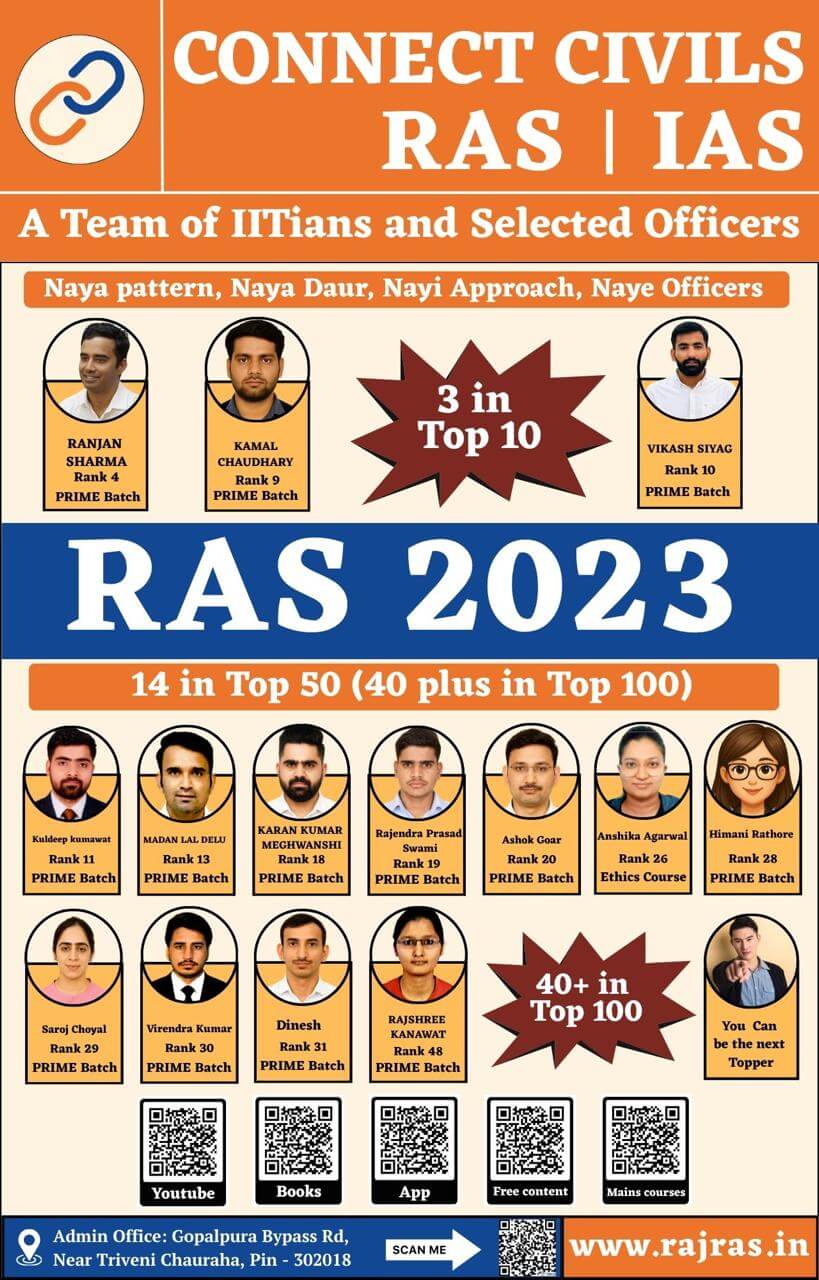In Rajasthan Geography, major environmental issues like desertification, water scarcity, and deforestation challenge the state’s arid landscape, from Jaisalmer’s Thar Desert to Udaipur’s Aravalli hills. These concerns, driven by climate change and human activities, impact agriculture, biodiversity, and sustainable development.
Rajasthan, known for its arid and semi-arid regions, unique biodiversity, and historical significance, faces several environmental challenges due to its harsh climatic conditions, rapid urbanization, and overexploitation of natural resources. These issues pose significant threats to the ecological balance, public health, and sustainable development in the state.
Major Environmental Issues seen in rajasthan are as follows
1. Water Scarcity
- Overexploitation of Groundwater:
- Rajasthan relies heavily on groundwater for agriculture and drinking purposes. Over Extraction has led to critical depletion levels in many regions, such as Jodhpur, Barmer, and Jaisalmer.
- Desertification:
- Low rainfall and overgrazing contribute to desertification, especially in the Thar Desert.
- Interstate Water Disputes:
- Sharing of water resources like the Chambal River often creates conflicts with neighboring states.
2. Desertification and Land Degradation
- Encroaching Desert:
- Approximately 61% of Rajasthan’s land is under desert, with the Thar Desert expanding due to deforestation, overgrazing, and poor agricultural practices.
- Soil Erosion:
- Wind erosion in arid regions and water erosion in semi-arid regions degrade land fertility.
- Deforestation:
- Cutting down of forests for fuelwood, grazing, and farming has exacerbated land degradation.
- Land Pollution: Rising domestic waste, e-waste, plastic waste, dumping of mine debris, Crop residue burning etc
3. Climate Change
- Change in rainfall pattern : According to IMD’s analysis, between 1989-2018, a period of 30 years, there has been a “significant” increase in heavy rainfall days in the entire year, particularly for the western parts of the state.
- Experts from the Indian Institute of Tropical Meteorology Pune → floods in Rajasthan are expected every third or fourth year.
- Monsoon patterns are becoming increasingly erratic, impacting agriculture and water availability.
- Rise in Heat waves lead to a sudden rise in heat-related casualties across the state : 120+ people have died in Rajasthan last summer season.
- Decreasing Groundwater Levels: Out of 302 blocks, 219 are in the dark zone due to excessive groundwater exploitation. 22 blocks are in critical condition, 20 in semi-critical condition, and only 38 in safe condition. Maximum groundwater exploitation (323%) occurs in Jaisalmer.
- Rising Temperatures:
- Rajasthan experiences extreme temperatures, with a consistent increase in average annual temperatures over the decades.
- Extreme Weather Events:
- Droughts and occasional floods are becoming more frequent, affecting livelihoods and infrastructure.
4. Loss of Biodiversity
- Habitat Loss:
- Expanding urbanization and industrial projects lead to habitat destruction for wildlife.
- Endangered Species:
- Species like the Great Indian Bustard, Indian Wolf, and Desert Fox face threats due to poaching and shrinking habitats.
- Invasive Species:
- Prosopis juliflora (an invasive plant) has disrupted native ecosystems.
5. Air Pollution
Centre for Science and Environment (CSE) Report → Particulate pollution in Rajasthan’s cities is rising, alongside increasing levels of gaseous pollutants like nitrogen dioxide and ground level ozone.
- Urban Air Quality:
- Cities like Jaipur, Jodhpur, and Udaipur face rising air pollution levels due to vehicular emissions, industrial activities, and construction dust.
- Mining Activities:
- Dust and particulate matter from mining operations, especially in areas like Bhilwara and Makrana, contribute significantly to air pollution.
- Crop Residue Burning:
- Though less prevalent than in northern states, some areas of Rajasthan still practice crop residue burning.
6. Water Pollution
- Industrial Effluents:
- Industries in cities like Pali, Balotra, and Kota discharge untreated effluents into rivers and water bodies, contaminating them.
- Increasing river water pollution in Luni and Banas due to the textile industry. Chambal river polluted by municipal and industrial discharge.
- Salinity issues affect groundwater in 89 blocks,particularly in desert regions, affects drinking water quality.
- Sewage Disposal:
- Poor waste management systems in urban and semi-urban areas lead to sewage contamination of water sources.
- Fluoride Contamination: High fluoride levels in water in regions like Pali, Baswara, and Nagaur lead to fluorosis.
7. Waste Management Issues
- Solid Waste Management:
- Rapid urbanization has resulted in inadequate waste disposal systems in cities like Jaipur and Jodhpur.
- Plastic Pollution:
- Improper disposal of plastic waste contributes to environmental degradation.
- E-Waste:
- The lack of proper e-waste recycling facilities exacerbates pollution in urban centers.
8. Overexploitation of Minerals
- Environmental Degradation from Mining:
- Mining activities in regions like Makrana, Bhilwara, and Udaipur lead to deforestation, habitat destruction, and soil erosion.
- Water Consumption:
- Mining consumes large quantities of water, exacerbating water scarcity in arid regions.
9. Urbanization and Infrastructure Development
- Unplanned Urban Growth:
- Cities like Jaipur and Udaipur face challenges due to haphazard urban expansion, leading to loss of green spaces and pressure on natural resources.
- Loss of Arable Land:
- Urban sprawl has encroached on fertile agricultural lands.
10. Agricultural and Grazing Pressure
- Overgrazing: Excessive grazing in rural areas leads to soil erosion and vegetation loss.
- Unsustainable Farming Practices:
Use of chemical fertilizers and pesticides degrades soil and pollutes water sources.
11. Deforestation
- Timber and Fuelwood Demand: Excessive demand for timber and firewood contributes to forest loss.
- Illegal Logging:
- Smuggling of valuable trees like Sandalwood has further exacerbated deforestation.
12. Tourism-Related Challenges
- Environmental Pressure in Tourist Destinations:
- Popular spots like Udaipur, Jaisalmer, and Mount Abu face challenges due to increased waste generation and resource consumption.
- Overexploitation of Natural Resources:
- Excessive water usage in hotels and resorts impacts local water availability.
13. Wetland Degradation
- Depletion of Lakes:
- Lakes like Sambhar Lake (India’s largest inland saltwater lake) are facing degradation due to illegal salt mining and pollution.
- Loss of Wetlands:
- Urbanization and agriculture have reduced the area and functionality of wetlands, affecting biodiversity and water retention.
Region wise environmental challenges
North-West Desert Region
- Change in Land Use Patterns and Increased water availability threatens desert flora and fauna.
- Non-native birds like the treepie and grey hornbill are now more common.
- The jungle cat is expanding, while desert foxes are reducing.
- GIBs are critically endangered, and their numbers have dwindled to just 50 out of 249 bustards, according to the 2021 report of IUCN.
- Human animal Conflicts: Desert wolves in conflict with shepherds due to human settlements.
- Increased agricultural fields and vegetation have led to a rise in the nilgai (Asian antelope) population.
- Desertification: In the context of Rajasthan, 62.06% (21.23 m.ha) of the total geographical area of the state was facing desertification/land degradation in 2018-19.
This area was 62.90% and 63.19% during the period 2011-13 and 2003-05 respectively.
A decrease of 0.84% in desertification/land degradation was observed between 2011-13 and 2018-19. The main causes of desertification/land degradation in the state are:
- Wind erosion [43.37%]
- Vegetation loss [7.64%]
- Water erosion [6.21%]
Between 2011-13 and 2018-19, there was a decrease in the area affected by wind erosion/deposition and an increase in the area affected by human activities. Whereas, between 2003-05 and 2011-13, there was a decrease in the area affected by wind erosion/deposition and an increase in the forest area affected by vegetation loss.
- Problem of SAM : Water logging in Ganganagar and Hanumangarh leads to marshy land with salt accumulation. Causes include excessive irrigation, gypsum layers, seepage, bowl-shaped topography, and lack of natural drainage.
Aravalli Region
- Deforestation: Widespread tree felling due to biotic interference, mining, industrialization, and climatic changes.
- Researchers from the Central University of Rajasthan (CURaj) found that Nearly 8% of Aravali hills have disappeared between 1975 and 2019. Losses are projected to rise to around 22% by 2059 if current urbanization and mining continue. Loss of vegetative cover leads to the Thar Desert drifting towards the northwest.
- Illegal Mining : In October 2018, a central empowered committee appointed by the Supreme Court informed that one-fourth of the Aravalli ranges in Rajasthan (31 out of 128 hills in the state) had disappeared over a 50-year period because of illegal mining.
Eastern Plain Area
- Soil Erosion: Significant soil erosion during rainfall.
- Mining Pollution: Mining activities contribute to pollution.
- Lack of Drinking Water: The Eastern Rajasthan Canal Project (ERCP) aims to address water scarcity.
Hadoti Region
- Rampant illegal sand mining in the Chambal river bed.
- Expansion of ravine landscapes (Beehad)
- Excessive exploitation of mountains for extraction of building stones.
Government Initiatives and Programs
The environmental challenges in Rajasthan stem from a combination of natural factors and human activities. Addressing these issues requires integrated efforts from the government, local communities, and other stakeholders.
Emphasis on sustainable development, resource management, and environmental education is critical to ensuring Rajasthan’s ecological and economic stability.
- UNFCCC COP and UNCCD COP14:
- India’s participation in the United Nations Framework Convention on Climate Change (UNFCCC) Conference of the Parties (COP) and the United Nations Convention to Combat Desertification (UNCCD) COP14 demonstrates the country’s commitment to global efforts in land restoration and combating desertification.
- National Forest Policy (NFP) 1988:
- goal – achieving a minimum of one-third (1/3) of the total land area under forest or tree cover.
- aim – maintain ecological balance, conserve natural heritage, and prevent soil erosion in river, lake, and reservoir catchment areas.
- Forest Fire Protection & Management Scheme (FFPM):
- This scheme focuses on preventing and managing forest fires, contributing to the overall health of forests.
- National Mission for a Green India (GIM):
- It aims to increase forest and tree cover, restore degraded ecosystems, and enhance biodiversity.
- It is under the National Action Plan on Climate Change (NAPCC)
- National Coastal Mission Programme:
- National Coastal Mission Programme on ‘Conservation and Management of Mangroves and Coral Reefs’, annual Management Action Plan (MAP) for conservation and management of mangroves are formulated and implemented in all the coastal States and Union Territories.
- Nagar Van Yojana (Urban Forest Scheme)
- The NVY was introduced in the year 2020 with a visionary objective – the creation of 1000 Nagar Vans (urban forests) in cities equipped with Municipal Corporations, Municipal Councils, Municipalities, and Urban Local Bodies (ULBs).
- State Climate Change Policy:
- This policy was created in 2023 to address climate change in the state.
- Rajasthan State Action Plan on Climate Change (SAPCC):
- Focuses on water resource management, biodiversity conservation, and promoting renewable energy.
- National Desertification Control Programme:
- Aims to combat desertification and improve land productivity.
- Jal Swavlamban Abhiyan:
- Promotes water conservation and rainwater harvesting.
- Renewable Energy Initiatives:
- Rajasthan is a leader in solar energy, with projects like the Bhadla Solar Park.
- Afforestation Programs:
- The state has launched plantation drives to combat deforestation and restore degraded lands.
- Rajasthan State Environment Policy:
- This policy was created in 2010 to identify and address environmental challenges in the state.
- E-Waste Management Policy:
- This policy was created in 2023 to manage e-waste in the state.
- Action plan to phase out single-use plastics:
- The government banned single-use plastics in government offices in 2022.
- Rajasthan State Pollution Control Board:
- This board was established in 1975 to prevent and control water pollution.
- The Environment (Protection) Act, 1986 expanded the scope of the board’s activities.
- Ecotourism:
- The state has a policy to promote ecotourism that focuses on local communities and conservation.
- Wetland conservation:
- The state has allocated funds for wetland and grassland development.
Major Environmental Issues / Major Environmental Issues / Major Environmental Issues / Major Environmental Issues / Major Environmental Issues / Major Environmental Issues / Major Environmental Issues / Major Environmental Issues / Major Environmental Issues / Major Environmental Issues

